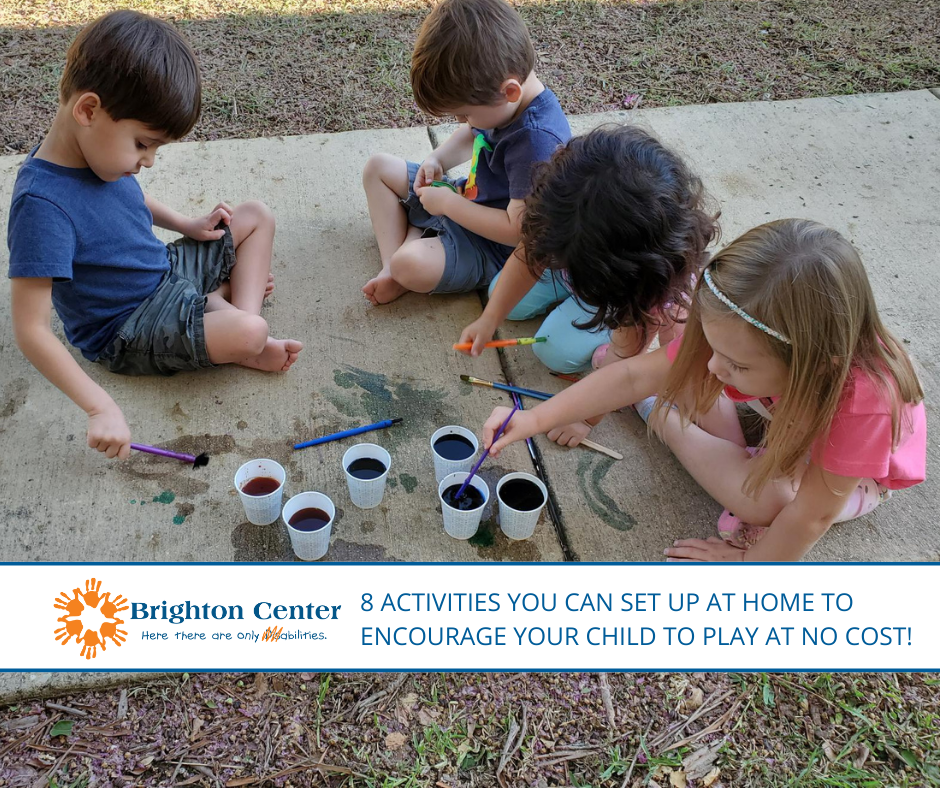By Emily Alvarez, MOT, OTR
Even before a child learns to walk, their natural impulse is to play. In fact, play acts as one of our earliest forms of exploratory learning. As our brains begin to develop, play creates a highly efficient way for children to acquire new information, skills, interests and to meet developmental milestones. Many parents fall into the trap of spending tons of cash on expensive toys and activities, but you can create deeply enriching activities that help develop your child’s skills and imagination without even spending a dime! In particular, here are 8 activities you can set up at home to encourage your child to play for free.
1 – Safari Hunt
Create binoculars with toilet paper rolls and hide stuffed animals around the house. Then, as your child finds the hidden animals, work on identifying the animals and making the sounds that the animals make. To adapt this game for older children, use sticky notes. Draw a letter or site word on each sticky note and hide several around the room. This fun game will work on visual perceptual skills and language development.
Make Your Own Toilet Paper Roll Binoculars – YouTube
2 – Science Experiments in the Kitchen
Gather some ingredients in your kitchen that you are comfortable having your child interact with. Afterwards, allow your child to touch, smell, taste and mix ingredients together. Some ingredients you might want to incorporate are spices, sugar, flour, cornmeal, and oats. You will be developing beginning principles of chemistry and giving your child an enriching sensory experience.
3 – Build a Fort
It doesn’t get more play for free than playing fort! Build a fort using sofa cushions, sheets, and blankets. Encourage your child to move the cushions to engage in heavy work during this activity. Afterwards, help your child decorate their tent using pillows and flashlights. To make it extra fun, allow your child to have a picnic in their fort and let them pretend they are on a campout. This activity facilitates proprioceptive input and encourages imagination.
Proprioceptive Input: The Magic Pill for Sensory Regulation – (theotbutterfly.com)
4 – Create a Vehicle
Use a large cardboard box to create a vehicle of your child’s choice. Let them decorate their car using crayons, markers, paint and/or stickers. Then, give your child places to “drive” and let them use their imagination as they tell you about their travels. This activity works on developing fine motor skills and pretend play.
How to Make a Cardboard Box Car – Parenting
5 – Play in the Mud
The idea of getting muddy makes many parents cringe but playing outside and getting dirty can be a fun, enriching play for free activity. Give your child age-appropriate tools to dig in the dirt. This might include plastic beach tools, spoons, plastic cups or just their hands. Additionally, point out different things in the soil including bugs, rocks, and roots. Then, let them experiment by adding water and watch your child’s imagination grow. In short, playing in nature gives parents a lot of opportunity to work on growing a child’s love for natural sciences.
6 – Create Shadow Pictures
Using the sun outside or flashlights inside, you can create shadows with objects or your body. Afterwards, using the shadow cast you can trace an outline of your child or object. If you are outside trace with chalk on the sidewalk or if inside trace on paper with marker or crayon. Then, have your child color in the picture you traced or attempt to trace one on their own. This activity will encourage creativity and promote fine motor skills.
Shadow Tracing | PBS LearningMedia
7 – Make Music
Instead of putting old boxes or plastic containers in the trash, collect them to create musical instruments. You can make shakers out of plastic bottles and rice. Also, you can make drums out of old plastic containers and use straws or chop sticks as drumsticks. You could even create a guitar out of a box and rubber bands. Furthermore, encourage your child to think of other ways they could use the materials to create music and assist you in putting them together. Once your musical instruments are created, enjoy playing together. This activity will promote fine motor skill development, provide fun auditory sensory input, and a great way to play for free because you’re using existing materials.
8 – Obstacle Course
Create a fun balance and problem-solving game using items around the house. For example, you can place pillows, pieces of furniture and blankets rolled up to create obstacles for your child to move through. For older children you could pretend the floor is lava and encourage them to only step on the obstacles placed on the floor. Then, have them attempt to get to different areas of the room without stepping on the carpet “lava”. This is a wonderful way to get in some heavy work during the day and work on gross motor skills.
Enjoy creating these fun, play for free activities for your child at home. Remember that play is one of their main forms of learning and will assist in developing lifelong skills.















